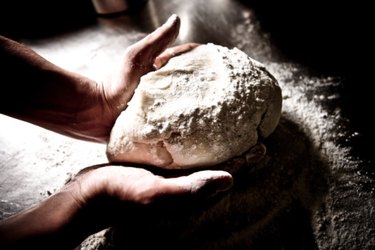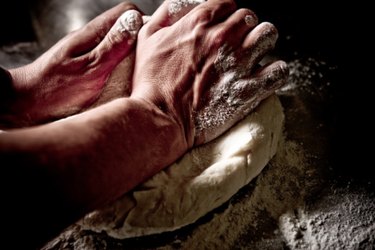
Air bubbles may form when the clay is prepared and they should be removed to avoid cracks in the pots you make. The process of removing air bubbles from clay can be performed manually, and is known as clay wedging. Clay manufacturers extract the air bubbles from clay using a special machine known as a pug mill.
Dangers of Air Bubbles in Clay
Video of the Day
Air bubbles in clay items are dangerous because they can cause explosions in the kiln. The air bubble dilates due to heat and forces the clay to crack or explode and shatter the ceramic piece. The risk of explosion increases with the temperature in the kiln. An explosion generally poses a risk only to the item that has air bubbles, and the other pieces that are fired in the same load are typically safe. However, the pieces resulting from the explosion may land on the elements of the kiln (the coiled wire inside the kiln) and in rare cases, this may cause a short circuit.
Video of the Day
Wedging Clay

Wedging, the process of kneading the clay to make it more homogenous, is also used to remove air bubbles from clay. The process is more commonly used in home-made clay, because commercial clay is already prepared into a homogenous paste and compressed so it doesn't contain air bubbles. The wedging is performed on an even surface, such as a table or a wooden board using your hands. Cut a manageable amount of clay and press the heels of your hands into the clay. Work the clay using a circular movement. This process is similar to kneading dough. Cut the clay in half using clay cutting wire and check for air bubbles. If you see air bubbles trapped, repeat the wedging.
Automatic "Wedging"
Mass manufacturers of clay remove air bubbles from clay using a pug mill. The clay is extracted from the earth and is mixed with water. The impurities and rock particles are removed and then the clay is dried to the desired consistency. The clay is inserted into the pug mill, mixed and pushed out from the machine, resulting in air-bubble-free clay. This process is similar to the manual wedging, but large amounts of clay can be compressed at one time.
Avoiding Air Bubbles
Air bubbles occur most commonly in hand-built pottery pieces, but may occur in thrown or slip-cast ceramics as well. To minimize the occurrence of air bubbles, it's important to wedge the clay properly prior to using it. After building a pot, always check for any empty spaces in the construction, such as where the clay coils or slabs are united, and apply some slip or liquid clay to cover these spaces. Don't add clay slabs or smaller amounts of hard clay to cover empty spaces, because you may trap air within the pot.